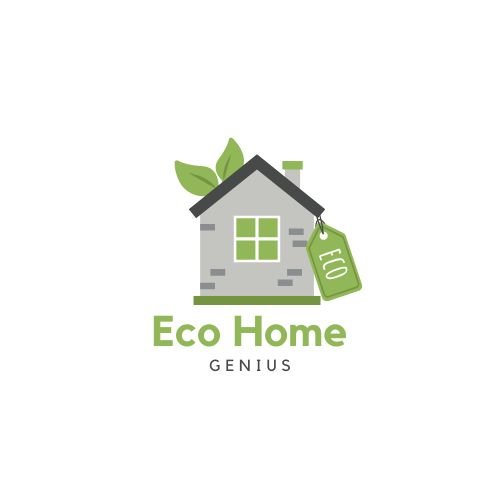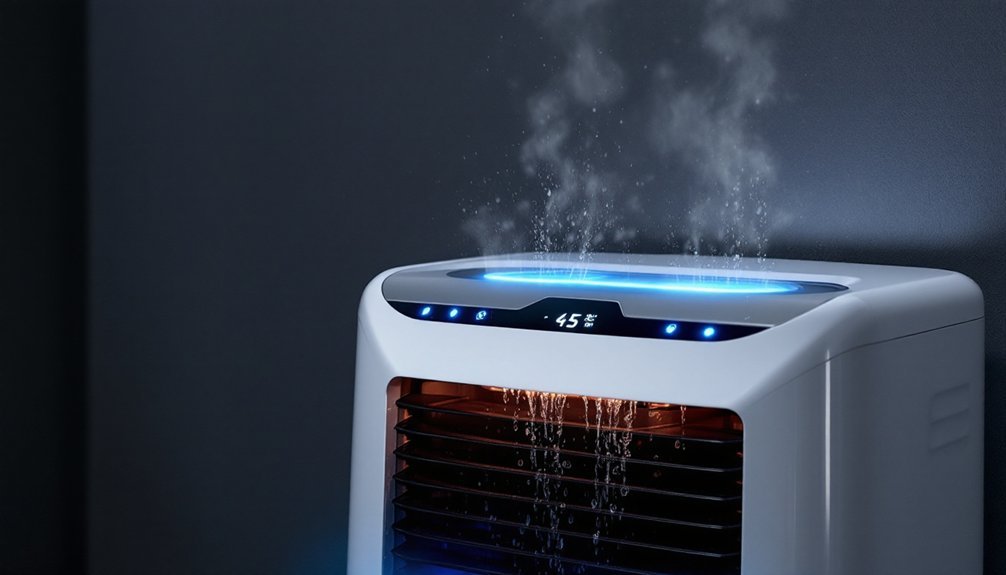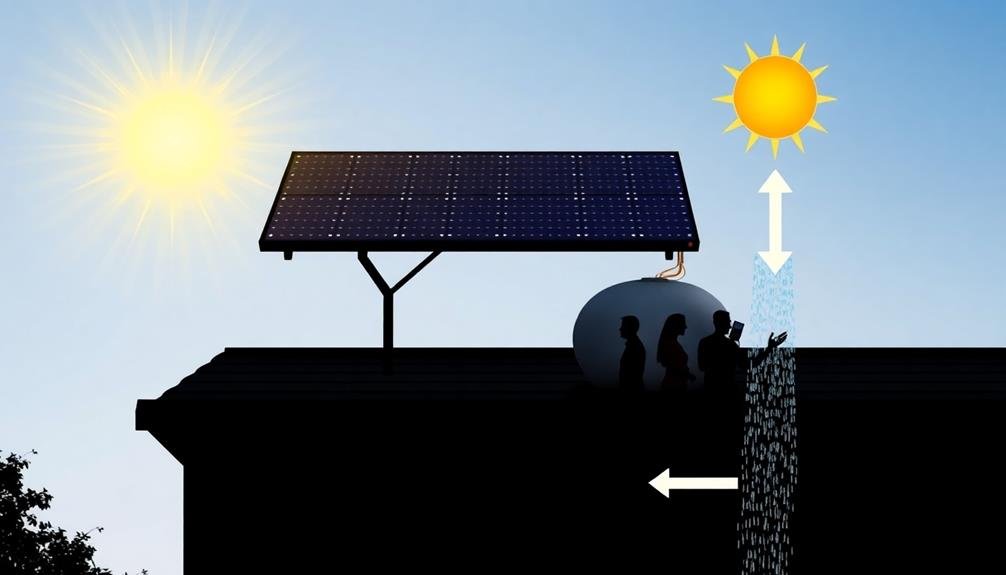If you're battling basement moisture, you'll want a dehumidifier that doesn't send your energy bills through the roof. Today's market offers several Energy Star certified options that can effectively tackle humidity while keeping operational costs in check. From compact units perfect for small spaces to powerful machines that can handle 4,500 square feet, there's an energy-efficient solution for every basement. Let's explore the top performers that'll help you maintain ideal humidity without breaking the bank.
80 Pints Energy Star Dehumidifier for Basement (JD025L-80)
The Fehom JD025L-80 stands out as an ideal choice for homeowners with large basements or spaces up to 5,000 square feet, especially if you're seeking powerful moisture control without excessive energy consumption.
You'll appreciate its impressive 80-pint daily moisture removal capacity and energy-efficient operation at just 275 watts. The unit features a user-friendly touch panel, real-time humidity display, and convenient mobility with 360° wheels. You've got two drainage options: a 1.06-gallon tank with handle or continuous drainage using the included 3.3-foot hose. The washable filter, automatic defrost, and thorough safety features guarantee reliable, low-maintenance performance backed by excellent warranty coverage.
Best For: Homeowners with large basements or spaces up to 5,000 sq. ft. who need powerful moisture control while maintaining energy efficiency.
Pros:
- High moisture removal capacity (80 pints/day) with energy-efficient operation
- Versatile drainage options with both manual tank and continuous drain capability
- Comprehensive features including touch panel, real-time display, and mobility wheels
Cons:
- Relatively heavy at 31.5 pounds, which may affect portability
- Garden hose for continuous drainage not included
- Water tank capacity (1.06 gallons) may require frequent emptying in very humid conditions
AEOCKY 4500 Sq.Ft Energy Star Dehumidifier with Drain Hose
Covering an impressive 4,500 square feet of space, AEOCKY's Energy Star dehumidifier stands out as an ideal choice for homeowners who need powerful moisture control in large spaces. You'll get exceptional performance with its 80-pint daily removal capacity and efficiency that works even in temperatures as low as 42℉.
What sets this unit apart is its smart technology with millisecond-level humidity detection and quiet operation at just 44dB. You won't have to worry about durability, thanks to its pure copper pipes and advanced heat exchange system. With five operating modes and a user-friendly interface, you're getting a reliable dehumidifier that can save you up to $1,000 annually on energy costs.
Best For: Homeowners with large spaces up to 4,500 sq. ft. who need powerful, energy-efficient dehumidification and value smart technology features.
Pros:
- Exceptional energy efficiency with Energy Star 2024 certification, potentially saving up to $1,000 annually
- Operates effectively at temperatures as low as 42℉, unlike typical models that stop at 65℉
- Extremely quiet operation at 44dB with advanced features like smart humidity detection and multiple operating modes
Cons:
- Higher initial price point compared to basic dehumidifiers
- Tank capacity of 1.45 gallons might require frequent emptying in very humid conditions
- "Full tank" alarm could be louder for better notification
34 Pints Dehumidifier for Home with Drain Hose (2500 Sq.Ft)
Perfect for homeowners with large spaces up to 2500 square feet, this 34-pint dehumidifier combines versatility with superior moisture control. You'll benefit from three operation modes: Continuous, Comfort, and Manual, letting you customize humidity levels from 30% to 90%.
The unit's top-grade compressor removes moisture 20% more efficiently than standard models, while maintaining whisper-quiet operation. You'll appreciate its compact design with built-in handle and wheels for easy mobility. Connect the included 6.6-foot drain hose for continuous operation, or rely on the 0.67-gallon tank with auto shut-off protection. It's ideal for basements, bedrooms, bathrooms, and wine cellars.
Best For: Homeowners with larger spaces who need efficient moisture control in basements, bedrooms, or humid areas up to 2500 square feet.
Pros:
- Highly efficient moisture removal with 20% better performance than standard models
- Versatile operation modes (Continuous, Comfort, Manual) with precise humidity control
- Includes drain hose for continuous operation and features easy mobility with wheels
Cons:
- Relatively small water tank capacity may require frequent emptying if not using drain hose
- Higher price point compared to basic dehumidifiers
- May be oversized for smaller spaces, potentially leading to energy inefficiency in rooms under 1000 sq ft
ANDTE 4500 Sq.Ft Energy Star Dehumidifier (52 Pints)
For homeowners seeking powerful moisture control, ANDTE's 4500 Sq.Ft Energy Star Dehumidifier stands out with its impressive 52-pint daily moisture removal capacity. You'll appreciate its energy-efficient operation, which can reduce your electricity bills by up to 37% compared to non-certified models.
The unit offers three dehumidification modes and intelligent touch controls with a humidity display, timer, and child lock. You can choose between manual tank emptying or continuous drainage using the included 6.56ft hose. The quiet operation and compact design make it perfect for basements, bedrooms, or offices. With an average removal of 5 gallons every 5 days, you'll notice the difference in your home's comfort quickly.
Best For: Homeowners with medium to large spaces up to 4500 sq ft who need efficient moisture control, particularly in basements, laundry rooms, or humid climates.
Pros:
- Energy Star certified with up to 37% reduction in electricity costs compared to non-certified models
- Versatile drainage options with both manual tank and continuous drain capability using included hose
- User-friendly features including intelligent touch controls, multiple modes, and quiet operation
Cons:
- 3L water tank capacity may require frequent emptying if not using continuous drainage
- Initial cost may be higher than non-Energy Star certified models
- Some users reported delivery issues, though product performance was satisfactory once received
Waykar 2000 Sq. Ft Energy Star Dehumidifier for Home
Homeowners seeking powerful yet energy-conscious dehumidification will find the Waykar 2000 Sq. Ft Dehumidifier an impressive choice. At just 190 watts, it's 45% more efficient than standard models, potentially saving you $1,000 annually on energy costs.
This ENERGY STAR certified unit removes 34 pints of moisture daily and operates at a whisper-quiet 33 dB. You'll appreciate its versatile features, including three fan speeds, adjustable humidity control (30-80%), and dual drainage options. The rotary compressor technology guarantees efficient performance while maintaining a compact footprint. While most users praise its effectiveness and quiet operation, some report occasional high-pitched noise issues.
Best For: Homeowners with medium to large spaces up to 2,000 sq. ft. who want an energy-efficient, powerful dehumidifier for basements, living rooms, or offices while prioritizing quiet operation and lower utility bills.
Pros:
- Highly energy efficient with ENERGY STAR certification and potential annual savings of $1,000
- Quiet operation at 33 dB with multiple fan speeds and drainage options
- Comprehensive safety features including child lock, auto shutoff, and power outage memory
Cons:
- Some users report high-pitched noise issues after extended use
- Limited water tank capacity of 0.6 gallons may require frequent emptying if not using continuous drainage
- Higher initial price point compared to non-Energy Star models
Waykar 80 Pints Energy Star Dehumidifier for Large Spaces
When managing moisture in large indoor spaces up to 5,000 square feet, the Waykar 80 Pints Energy Star Dehumidifier stands out as a robust solution. You'll appreciate its ability to remove up to 80 pints of moisture daily in high-humidity conditions.
This unit's intelligent control panel lets you adjust humidity levels from 30% to 80%, while its Energy Star certification helps reduce your power bills. You've got flexible drainage options – either use the 4L reservoir or connect the included drain hose for continuous operation. The built-in features like auto defrost, self-drying, and child lock guarantee safe, efficient performance.
Best For: Large homes, basements, or offices up to 5,000 sq. ft. where efficient humidity control and energy savings are priorities.
Pros:
- Powerful moisture removal capacity of 80 pints per day with Energy Star certification for cost efficiency
- Versatile drainage options with both manual reservoir and continuous drain hose included
- Intelligent control panel with adjustable humidity settings and convenient features like child lock and auto defrost
Cons:
- Some users report reliability issues and unit failures after limited use
- Heavy unit at 28.44 pounds, despite having wheels for mobility
- Mixed experiences with warranty claims and customer service response times
PlUSCENT 1500 Sq.ft Basement Dehumidifier
The PlUSCENT 1500 Sq.ft Basement Dehumidifier stands out as an ideal choice if you're seeking powerful moisture control in a compact, user-friendly package. With its ability to extract 2.5 gallons daily at peak conditions, you'll notice a significant difference in your indoor air quality.
You'll appreciate its three operational modes: DEHU for smart humidity control, DRY for quick moisture removal, and CONT for persistent dampness. The touchscreen interface lets you easily adjust settings, while the 360° wheels make repositioning effortless. Whether you're using it in your basement, bedroom, or RV, its whisper-quiet operation won't disturb your daily activities.
Best For: Homeowners and RV users seeking an efficient, versatile dehumidifier for spaces up to 1500 square feet, particularly those dealing with persistent moisture issues in basements or living areas.
Pros:
- Powerful moisture extraction capability of 2.5 gallons daily with three versatile operating modes
- User-friendly design with touchscreen controls, 360° wheels, and convenient carrying handles
- Quiet operation and compact size make it suitable for any room including bedrooms
Cons:
- Water tank capacity of 0.39 gallons requires frequent emptying without drain hose setup
- Display lights cannot be dimmed for nighttime use
- Coverage area may be insufficient for larger homes or extremely damp spaces
Factors to Consider When Choosing Energy-Efficient Dehumidifiers for Basements
If you're shopping for an energy-efficient basement dehumidifier, you'll need to evaluate several vital factors to make a smart choice. First, consider the coverage area specifications, whether it has Energy Star certification for peak efficiency, and the daily moisture removal capacity that matches your needs. You'll also want to examine the available drainage options and check the operating temperature range to guarantee the unit can function effectively in your basement's conditions.
Coverage Area Requirements
Choosing the right coverage area for your basement dehumidifier stands as a critical first step in maintaining ideal humidity levels. You'll need to match your basement's square footage with a unit that can effectively service the space, with options ranging from 2,000 to 5,000 square feet.
For larger basements, you'll want to evaluate models with continuous drainage capabilities, eliminating the need for frequent manual emptying of water tanks. These units can handle between 34 to 80 pints of moisture daily, depending on your specific conditions. When measuring your space, don't forget to account for high humidity levels, as some basements can reach up to 90% relative humidity. Look for a dehumidifier that can maintain your desired humidity setting, with adjustable controls typically ranging from 30% to 80%.
Energy Star Certification
When selecting an energy-efficient dehumidifier for your basement, Energy Star certification should top your list of priorities. These certified units consume 10-50% less energy than standard models, which means you'll see noticeable savings on your electricity bills over time.
Look for dehumidifiers with the Energy Star Most Efficient designation, as these represent the cream of the crop in energy-saving performance. They're equipped with cutting-edge technologies, including high-performance compressors and advanced humidity control systems that maximize moisture removal while minimizing power consumption. You'll not only save money but also reduce your environmental impact by lowering greenhouse gas emissions. Since basement dehumidifiers often run continuously, choosing an Energy Star certified model can make a significant difference in both your utility costs and carbon footprint.
Daily Moisture Removal Capacity
Daily moisture removal capacity stands as a critical factor in selecting the right dehumidifier for your basement. You'll find this capacity measured in pints per 24 hours, typically ranging from 34 to 80 pints for home units.
To effectively manage your basement's humidity, you'll need to match the dehumidifier's capacity to your space size. For larger basements up to 5,000 square feet with high moisture levels, you'll want a unit with higher pint capacity. Remember that performance varies with environmental conditions – units perform differently at various temperature and humidity levels.
Look for models with real-time humidity displays and adjustable settings so you can fine-tune moisture control. Choosing a dehumidifier with higher daily moisture removal capacity won't just reduce humidity – it'll improve air quality and prevent mold growth in your basement.
Drainage Options Available
Modern dehumidifiers offer two primary drainage options to suit your basement's needs: manual tank collection and continuous drainage systems. With manual drainage, you'll need to monitor and empty the water tank regularly. Larger tanks reduce the frequency of emptying, making maintenance more convenient, especially in high-humidity conditions.
If you prefer a hands-off approach, continuous drainage might be your best choice. You can connect a hose to your unit, allowing water to flow directly to a drain or sump pump. While some models include the drainage hose, you may need to purchase one separately for others. Don't worry about overflow issues – most units feature automatic shut-off mechanisms that stop operation when the tank is full or when your desired humidity level is achieved, protecting your basement from water damage.
Operating Temperature Range
Temperature range plays an essential role in your dehumidifier's performance and energy efficiency. While standard units struggle below 65°F, you'll want to take into account advanced models that can operate effectively down to 42°F, especially if you're using the unit in a cool basement.
When temperatures drop too low, your dehumidifier won't just become less efficient – it may stop working altogether and develop ice buildup. That's why it's vital to choose a model specifically designed for cooler environments. Energy-efficient dehumidifiers often feature broader temperature ranges, ensuring they'll maintain consistent performance regardless of seasonal changes. Before making your purchase, evaluate your basement's typical temperature and humidity levels. This assessment will help you select a unit that won't waste energy while effectively controlling moisture in your space.
Noise Level Considerations
When selecting a basement dehumidifier, noise level can make or break your comfort. You'll want to look for models that operate at 44 dB or lower, especially if you're planning to run the unit during nighttime hours. Most energy-efficient dehumidifiers operate between 33 to 50 dB, with quieter models featuring soundproof panels for minimal disruption.
Consider how you'll use the space where your dehumidifier will run. If it's a frequently used area like a finished basement or bedroom, prioritize units with multiple fan speeds. You can switch to lower, quieter settings when you're in the room, though keep in mind this may extend the dehumidification time. Look for models that balance performance with noise reduction, as user experiences consistently show that quieter operation greatly improves satisfaction with the unit.
Size and Portability
Selecting the right size and portability features for your basement dehumidifier will directly impact its effectiveness and convenience. You'll need to match the unit's capacity to your basement's square footage, with options ranging from 34 pints for smaller areas to 80 pints for spaces up to 5,000 sq. ft.
Look for models with 360° wheels and built-in handles, which make it easy to move your dehumidifier between different basement areas. If you're working with limited space, you'll appreciate compact designs that fit in tight spots while still removing moisture effectively. Consider units weighing between 22 to 35 pounds for easier transport and seasonal storage. Don't forget to check for practical features like power cord storage and user-friendly control panels, which will make daily operation more manageable.
Maintenance and Filter Types
Beyond size and mobility features, maintaining your dehumidifier properly guarantees peak performance and energy savings. You'll need to focus on the filter system, which comes in two main types: washable and disposable. Washable filters offer cost benefits since you can reuse them multiple times, while disposable ones require replacement every 3-6 months.
Regular filter maintenance can boost your dehumidifier's efficiency by up to 50%, resulting in better moisture control and reduced energy bills. Most modern units include a filter indicator that'll remind you when it's time for cleaning or replacement. By keeping up with filter maintenance, you're not just extending your unit's lifespan – you're also improving your basement's air quality by preventing dust and allergens from circulating throughout the space.
Frequently Asked Questions
How Long Do Energy-Efficient Dehumidifiers Typically Last Before Needing Replacement?
You'll typically get 5-10 years from an energy-efficient dehumidifier if you maintain it properly. With regular cleaning and filter changes, it can last longer, but performance may decline after the 5-year mark.
Can I Use a Dehumidifier in an Unfinished Basement With Exposed Insulation?
Yes, you can use a dehumidifier in an unfinished basement with exposed insulation, but you'll want to keep it away from any loose fiberglass material and guarantee proper airflow around the unit for safety.
Will Running a Dehumidifier Affect My Home's Heating and Cooling Costs?
Yes, your dehumidifier will impact energy costs. You'll see a slight increase in electricity bills, but it can help your AC work more efficiently in summer since less humidity means your home feels cooler.
Do Basement Dehumidifiers Need Professional Installation or Maintenance?
You won't need professional installation for most basement dehumidifiers – they're plug-and-play. Just empty the water tank regularly and clean the filter monthly. Annual coil cleaning is all the maintenance you'll typically need.
How Often Should I Clean the Internal Components of My Dehumidifier?
You'll need to clean your dehumidifier's filter monthly and wipe down the water bucket every few weeks. Deep clean internal components like coils and fans every 6 months to maintain efficiency and prevent mold growth.





Leave a Reply